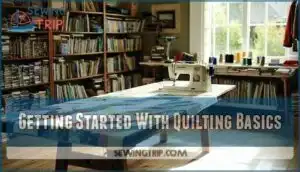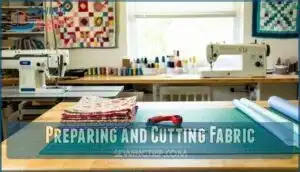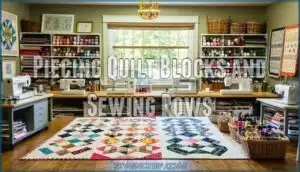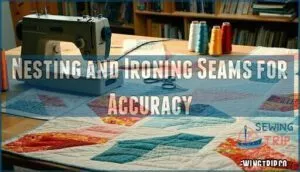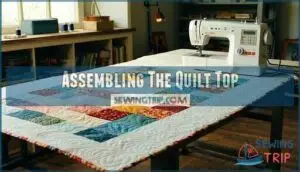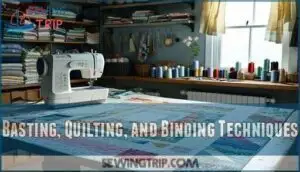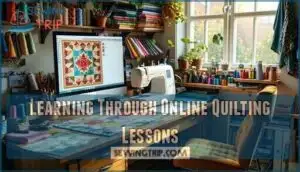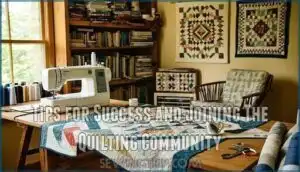This site is supported by our readers. We may earn a commission, at no cost to you, if you purchase through links.
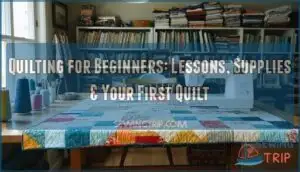
If you’re tired of patterns that look like everyone else’s, quilting for beginners lessons are your ticket to creating something that’s all yours. You’ll learn how to wrangle fabric, master the tools, and find your rhythm—no experience required. Get ready to turn raw material into a quilt that tells your story.
Table Of Contents
Key Takeaways
- Starting with quality basic tools and precut fabrics makes quilting easier and less overwhelming for beginners.
- Online quilting lessons and virtual workshops offer flexible, expert guidance to help you build skills at your own pace.
- Connecting with quilting groups, magazines, and blogs sparks creativity and gives you a sense of community.
- Embracing mistakes and practicing patience are key to growing your confidence and mastering quilting techniques.
Essential Quilting Supplies for Beginners
You can’t build a quilt without the right gear. Getting set up properly from the start saves you frustration and helps you fall in love with the process instead of fighting your tools.
Here’s what you actually need to get going.
Must-Have Quilting Tools and Equipment
You don’t need a mountain of gear to start quilting—just a few smart essentials that’ll set you up for success from day one. Focus on quality over quantity. A reliable sewing machine is your foundation. Pair it with sharp cutting tools like a rotary cutter, accurate measuring devices, and solid ironing tools. These quilting supplies will carry you through every sewing technique you’ll learn.
Your starter toolkit:
- Sewing machine with a straight stitch and quarter-inch foot
- Rotary cutter for fast, clean fabric cuts
- Measuring tools like a clear acrylic ruler
- Iron and pressing surface for crisp seams
Recommended Cutting Mats and Rotary Cutters
A clean cut starts with the right mat—and the right rotary cutter makes all the difference. Look for a self-healing cutting mat with clear grid lines to guide your fabric cutting.
Pair it with a rotary cutter that feels comfortable in your hand—ergonomics matter when you’re slicing through layers. Keep blades sharp for clean edges and always engage the safety lock between cuts.
Regular mat maintenance keeps your quilting tools working like new.
Choosing Fabric—Yardage Vs. Precuts
Once you’ve got your cutting tools dialed in, the real fun begins—picking out fabric that speaks to you. Here’s what you need to know:
- Precut fabric like charm packs takes the guesswork out of fabric selection and cutting—perfect when you’re just starting out
- Yardage gives you freedom and flexibility but requires careful yardage calculation and confident cutting skills
- Color coordination feels easier with precuts since designers already paired the prints for you
- Precut benefits include zero waste and instant gratification—you can start piecing right away
- Choosing quilt fabric by the yard costs less per square inch once you master quilt fabrication basics
Start with precuts to build confidence, then branch into yardage as your skills grow.
Setting Up Your Quilting Workspace
Your fabric’s sorted and your tools are ready—now let’s carve out a space where you can actually get things done. You don’t need a Pinterest-worthy sewing station, but smart workspace organization makes everything easier.
Even a corner of your dining table works when you prioritize these basics.
| Workspace Element | Why It Matters |
|---|---|
| Sewing Machine Placement | Keep it at elbow height for quilting ergonomics—no hunching over |
| Lighting Essentials | Bright overhead and task lighting prevent eye strain during sewing lessons |
| Ironing Board Access | Position it within arm’s reach for quick seam pressing between blocks |
| Storage Solutions | Clear bins keep quilting supplies visible and quilting tools organized |
| Cutting Surface | Large, stable table protects your back and improves accuracy |
Getting Started With Quilting Basics
You’ve got your tools and fabric ready. Now it’s time to learn the language of quilting and pick your first project.
Here’s what you need to know before you start piecing.
Understanding Quilting Terminology
Before you can dive into your first project, you’ll need to speak the language—quilting has its own vocabulary that makes patterns and tutorials much easier to follow. Terms like "fat quarter" and "binding" will pop up everywhere.
A basic stitch glossary helps you understand what "basting" or "piecing" means. Familiarizing yourself with fabric types and sewing notions saves confusion later.
Once you know the quilting terminology, those beginner quilting guides start making real sense.
Selecting Beginner-Friendly Projects
The right project can make or break your early quilting experience—pick something too complicated and you’ll end up frustrated, but choose wisely and you’ll build confidence with every stitch.
Start with simple quilt patterns that focus on basic piecing and straightforward quilt designs. Look for beginner quilting projects with clear instructions and minimal fabric choices.
Smaller project sizes let you finish faster and master essential quilting techniques without getting overwhelmed.
Using Charm Packs for Easy Quilt Starts
Charm packs are a beginner’s secret weapon—these bundles of coordinated 5-inch fabric squares let you skip the intimidating measuring and cutting and jump straight into sewing your quilt.
Here’s why they’re perfect for beginner quilting and patchwork quilting:
- Fabric selection is done for you—designers pair prints that work together beautifully
- Charm pack projects require minimal cutting, saving time and reducing mistakes
- You can test quilt patterns without buying full yardage
- These sewing essentials make choosing a charm pack the smartest beginner tip for quilting for beginners
Step-by-Step Guide to Making Your First Quilt
Now it’s time to roll up your sleeves and make your first quilt. This section breaks down the entire process into manageable steps—from cutting your fabric to adding the final binding.
You’ll learn the techniques that turn separate pieces into a finished quilt you can be proud of.
Preparing and Cutting Fabric
Cutting straight lines sounds simple until you’re staring at three yards of fabric wondering where to make the first snip. Start with fabric preparation—press out wrinkles and square up edges using a rotary cutter and cutting mat.
For quilting for beginners, precut fabrics like fabric squares take the guesswork out of yardage calculation. When choosing quilt fabric from yardage, measure twice and cut once.
Master these fabric cutting techniques and patchwork quilting becomes less intimidating.
Piecing Quilt Blocks and Sewing Rows
Once your fabric is cut and stacked, it’s time to actually stitch those pieces together into blocks that look like they belong in the same quilt. Match edges carefully and use a consistent quarter-inch seam for proper block construction.
Sewing quilt rows means following your quilt block patterns exactly—fabric placement matters when you’re building patchwork. Online quilting tutorials help improve your sewing skills as you master row assembly and seam management.
Nesting and Ironing Seams for Accuracy
Nesting seams is where your quilt blocks go from lopsided to perfectly squared—and a hot iron is your secret weapon for making those intersections lock into place. Press seams in opposite directions so they nest together like puzzle pieces.
This fabric nesting technique creates quilting precision at every corner. Your ironing tips matter—use steam and firm pressure for crisp seam pressing that holds your quilt layout design together.
Assembling The Quilt Top
Now that your seams are pressed and nested, you’re ready to stitch those rows together and watch your quilt top come to life. Line up your patchwork corners and pin those seam intersections.
This quilt top assembly transforms fabric layout into a finished design. Your block construction and seam management pay off here—each row connects the pattern selection you chose earlier.
This is where the quilt-making process clicks and your sewing skills shine.
Basting, Quilting, and Binding Techniques
With your quilt top finished, it’s time to layer everything together and lock in those stitches with basting, quilting, and binding. Start with batting selection—pick a loft that matches your project.
Quilt basting holds your layers steady for hand quilting or machine work. Those quilting techniques you’ve practiced come alive in quilt finishing. Machine binding wraps it all up. These quilt binding techniques complete your masterpiece.
Learning Through Online Quilting Lessons
You don’t have to learn quilting alone anymore. Online lessons give you expert instruction from your own home at your own pace.
Let’s look at what’s available to help you build your skills with confidence.
Overview of Free and Paid Beginner Classes
Curious about Quilting for Beginners? You’ll find over 250 free Online Tutorials and Quilting Classes, with step-by-step Sewing Tutorials and downloadable patterns.
Paid Beginner Lessons and Quilting Workshops range from $15 to $110, covering everything from Class Formats to sophisticated techniques. Online Workshop options and flexible Course Pricing make Quilting Education accessible, whether you crave structure or want to experiment.
For a thorough learning experience, explore the quilting classes offered by various instructors.
Benefits of Virtual Workshops and EBooks
You can dive into Virtual Learning or browse EBook Resources while sipping coffee in your pajamas. Online Tutorials and Digital Classes break down techniques with clear visuals.
Quilting Webinars and Online Workshops offer step-by-step guidance for Quilting for Beginners. With Online Quilting Classes and Sewing Tutorials, you control the pace—no pressure, just pure Quilting Education whenever you’re ready.
Notable Instructors and Upcoming Events
Energy and inspiration flow from Quilt Conferences like QuiltCon 2025, where Instructor Profiles shine and Quilting Workshops fill up fast. You’ll spot Teacher Awards and meet legends such as Jenny Doan from Missouri Star Quilt Co.
The Event Calendars brim with Quilting Classes and Sewing Classes—real chances to grow your skills and join a thriving Quilting Community and Resources. Beginners can start with a quilt class online to learn the basics of quilting.
Tips for Success and Joining The Quilting Community
Quilting is more than fabric and stitches—it’s about growing your skills and finding your people. If you’re ready to take the next step, there are plenty of ways to build confidence and connect.
Here’s where you can start making quilting part of your life.
Practice, Patience, and Skill-Building
Every stitch you make is a small step toward mastering the art of quilting, so don’t be afraid to let patience lead the way. Skill building happens one seam at a time.
Patience and practice turn each stitch into progress, guiding you step by step toward mastering the art of quilting
Explore quilting tutorials for new sewing techniques and quilting tips and tricks. Focus on Quilt Design and Fabric Management—these Quilting Fundamentals will turn beginner quilters into confident stitch masters.
Connecting With Local Guilds and Groups
Belonging in the Quilting Community can turn isolation into inspiration. Guild Membership creates opportunities to Quilter Networks, Twin Cities Quilting, and Minneapolis Quilting Classes. Local Workshops and Community Events spark creativity. Quilt Shows showcase your progress. Quilters Haven is more than a shop—it’s your tribe. Here’s how to plug in:
- Join a guild
- Attend local workshops
- Participate in community events
- Visit Quilt Shows
- Connect at Quilters Haven
Finding Inspiration From Magazines and Blogs
Ever notice how flipping through a quilting magazine or scrolling a blog can spark ideas you never knew you’d? Magazine subscriptions keep you current on Quilting Trends, while Blog Reviews highlight fresh Quilt Inspiration.
Online Forums and Quilting Tutorials—like Sew Easy Lessons from Quiltmaker—offer practical Quilt Making Tips. The Quilting Community is always weaving new stories to fuel your creativity.
Continuing Your Quilting Education
There’s always another layer to uncover in quilting, and your journey doesn’t have to stop with your first finished project. Try these ways to keep growing:
- Join Quilting Workshops or Classes
- Explore Online Courses and Sew Easy Lessons
- Experiment with new Quilt Patterns and Techniques
- Upgrade your Quilting Tools and Sewing Machines
- Dive into Quilting Tutorials for skill-building
Frequently Asked Questions (FAQs)
How do I fix common quilting mistakes?
Spot a wonky seam or a misaligned block? Mistake Correction starts with a seam ripper. Quilt Repair means gentle unpicking, re-sewing, and pressing.
Error Prevention comes from slowing down and checking your work—classic quilting tips from any reliable quilting tutorial.
What thread types work best for quilting?
Imagine picking thread like choosing vinyl records—each adds its own vibe. Cotton Threads are classics for quilting.
Explore Thread Weights, Fiber Blends, and Color Choices.
Tension Control matters, especially with your sewing machine and quilting supplies.
How do I care for finished quilts?
Keep your finished quilts fresh by storing them flat or rolled, away from sunlight.
Gentle hand washing works best for fabric cleaning. Avoid dry cleaning.
Display quilts on a rack or wall, and use proper quilting supplies for care.
What are easy quilting patterns for kids?
Kid Friendly Blocks and Simple Quilt Designs like rail fence, four-patch, or checkerboard work well for Youth Sewing Projects.
Try Beginner Quilting Kits, Easy Patchwork, and Sew Easy Lessons for fun, accessible quilting patterns and techniques.
How do I store quilting supplies safely?
Picture your crafting space as a well-tuned engine—Storage Solutions like labeled bins, supply shelves, and drawer dividers keep quilting supplies organized.
Store quilting fabric flat, maintain quilting tools, and cover your sewing machine for safe, lasting use.
Conclusion
It’s no coincidence that every quilter remembers their first crooked seam or mismatched block. Those moments shape your journey.
As you explore quilting for beginners lessons, you’ll discover that creativity grows from imperfection. Each stitch, each choice of fabric, becomes part of your story. You’re joining a community that celebrates boldness and individuality.
With every quilt you make, you’ll find new confidence and inspiration—proof that your hands and heart can create something truly unique.

